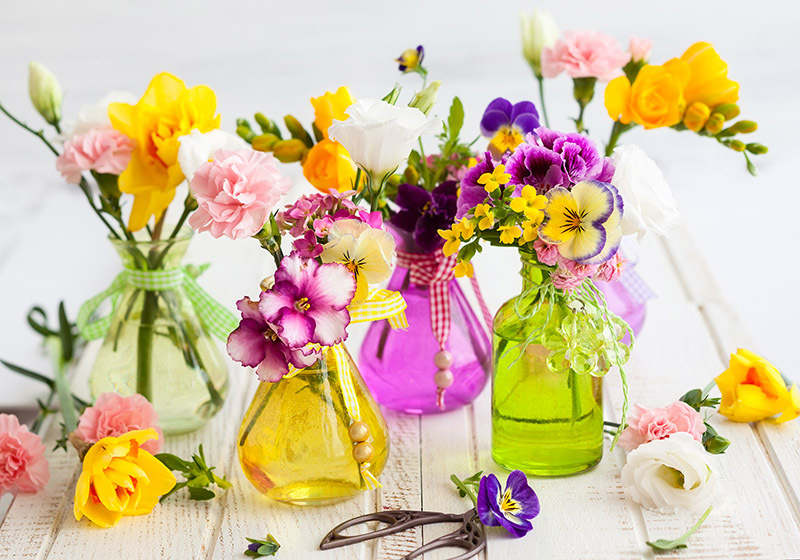Unlock the Mysteries of Tulip Colors and Their Meanings!
Tulips, with their vibrant hues and delicate blooms, have long captured the imagination of garden enthusiasts and artists alike. Originating from the Ottoman Empire and brought to Europe in the 16th century, these blooms have become a symbol of beauty, transience, and renewal. However, did you know that the color of a tulip can carry significant meanings, ranging from love to friendship to gratitude? In this article, we'll delve into the fascinating world of tulip colors and uncover their hidden meanings.
The Symbolism of Tulip Colors
Flowers have their unique language, known as 'floriography', which became immensely popular especially during the Victorian era. Tulips, with their array of shades, have special meanings attributed to each color. Here, we will explore some of the most popular tulip colors and their intriguing lore.

Red Tulips
Perhaps the most iconic of tulip colors, red tulips symbolize deeply passionate love. Similar to red roses, they are often used as declarations of romantic intent. Giving a bouquet of red tulips expresses a strong desire and romantic passion. If you're searching for a flower that speaks the language of the heart, red tulips are a perfect choice.
Pink Tulips
Pink tulips convey a sense of affection and caring. Often associated with happiness and confidence, pink tulips are suitable for many occasions, whether it be to celebrate the birth of a new baby or to show appreciation for someone's kindness. They're ideal for expressing sentiments of care, making them a perfect gift for friends and family.
Yellow Tulips
Once representing hopeless love, yellow tulips have taken on a more joyous significance in modern times. Now, they are commonly seen as symbols of friendship, cheerfulness, and hope. They're perfect for brightening someone's day or conveying happiness and sunshine in troubling times.
White Tulips
White tulips are often used in contexts of purity, forgiveness, and respect. They can be used to express a gesture of apology or to signify a new beginning. Their elegant simplicity makes them a popular choice for weddings, symbolizing unity and peace.
Purple Tulips
The color purple has often been associated with royalty and elegance. Similarly, purple tulips are symbols of luxury and admiration. They impart a sense of sophistication and elegance, making them a splendid choice for occasions celebrating dignity and respect.
Orange Tulips
Orange tulips convey enthusiasm and desire. They're vibrant and full of energy, symbolizing happiness and a sense of excitement. When you're looking to uplift someone's spirits or celebrate a joyous moment, orange tulips are the flowers to choose.
Multicolored Tulips
Beyond single-color tulips, there are those that boast a fascinating combination of hues. These unique tulips, often variegated with different shades, can carry complex meanings. For instance, a tulip with a mix of red and yellow can signify friendship turning into romance, offering a thoughtful gift for someone you're developing feelings for.
The History and Significance of Tulip Colors
Since their introduction to Europe, tulips have traversed many cultural contexts, each imparting unique significance to their colors. Tulips experienced immense popularity in the 17th century during the period of 'Tulipmania' in the Netherlands, when the price of tulip bulbs soared to astonishing heights. This period reflects the flower's immense allure and the cultural significance it obtained, emphasizing how a single flower could symbolize wealth and status.
Cultivating Tulips: Tips for Gardeners
If you're fascinated by tulips and wish to cultivate them in your garden, understanding the preferences of tulips can be immensely rewarding:
- Location and Planting: Tulips prefer well-drained soil conditions and full sunlight. It's crucial to plant them in a location that receives ample sunlight to enhance their growth.
- Planting Time: The best time to plant tulip bulbs is in the autumn, before the first frost. This allows bulbs to establish roots before the chilling winter months.
- Watering: While tulips need adequate watering after planting and during dry spells, overwatering can lead to bulb rot. Careful watering is key.
- Post-Bloom Care: Once the tulips have bloomed, remove the spent flowers to prevent seed formation. Allow the leaves to die back naturally, as they help return nutrients to the bulb for next season's growth.

The Charm of Tulip Gardens
Creating and maintaining a tulip garden can bring endless joy and beauty. The sight of countless colorful blooms swaying in the spring breeze is a vision to behold. Consider arranging tulips by their color meanings to create a message or theme within your garden.
Conclusion: Embracing the Language of Tulips
Interpreting the colors of tulips adds depth to their beauty and offers a unique way to communicate sentiments without words. Whether you are gifting tulips to express love, joy, or admiration, understanding what each color represents can transform a simple bouquet into a heartfelt expression.
As you explore more about these captivating flowers, remember that tulips are not just a springtime attraction; they are a living canvas painting an array of sentiments and stories. So, the next time you find yourself amidst these vibrant blooms, take a moment to appreciate the symphony of colors and the meanings they hold.
In a world where we seek to understand one another often beyond words, the colors of tulips offer a gentle and fragrant means to connect, inspire, and convey the most profound emotions.

